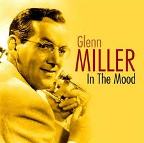Clarinet Gateway – Jimmy O’Bryant Washerboard Band
Tar Paper Stomp – Wingy Manone
In The Mood – Glenn Miller
The opening notes to Glenn Miller’s In the Mood is one of the most recognisable of all time and indeed was a million seller for Glenn, but it was not his first, that honour goes to the slightly lesser known Little Brown Jug. It took a lot longer to sell a million copies back in those days. Both of the aforementioned songs were both released in 1939 but did not reach the million mark until (Little Brown Jug) 1943 and (In the Mood) 1945. Sadly Glenn died the year in between when he disappeared over the English Channel so never got to see the tremendous achievement of the latter.
In The Mood, which had a slightly risqué title back then as in the mood is an expression that indicates the desire to make love and that was considered taboo, was not written by Glenn, nor did he do it first. The origins of the song go back even further, and they say nothing is original today!
Jimmy O’Bryant was a bandleader from Arkansas who occasionally undertook short stints with Jelly Roll Morton, W.C. Handy and King Oliver. When he went to Chicago he accompanied Ida Cox, Alberta Hunter, Ma Rainey and Ethel Waters. His band was a four-piece, with him on clarinet, Jimmy Blythe on piano, Bob Shoffner on cornet and Jasper Taylor on washboard and went under the name Jimmy O’Bryant’s Washboard Wonders. The track, which was penned by the pianist Jimmy Blythe, was originally called Clarinet Gateway and first recorded in 1925.
Five years later it was covered by another band leader and one-armed trumpeter called Wingy Manone with his band The Cats and decided to re-title it The Tar Paper Stomp. Bizarrely later the same year it was covered again by the unlikely named Barbecue Joe & His Hot Dogs which was an alias for Joseph ‘Wingy’ Manone, an alias he used when recorded for the Gennett record label. In 1931 yet another band leader, Fletcher Henderson, did a version under the title Hot ‘n’ Anxious. In 1935 the Mills Blue Rhythm Band gave it a go with a slightly different arrangement that was written by Joe Garland who was a saxophone player in Lucky Millinder’s band and called it There’s Rhythm in Harlem. In 1938 The Edgar Hayes Orchestra recorded it for the Decca label and called it, for the first time, In the Mood. Garland was a member of Edgar Hayes’ orchestra and this version features a baritone saxophone duet rather than a tenor one that has become more famous.
Although the tune had been played hundreds of times in ballrooms across the US, the tune had never been written down, so when Garland put pen to paper, he claimed it as his own. He sold the original track to the band leader Artie Shaw but after buying it and then hearing it, he decided that the original eight minute version was too long and declined to record it. It was then sold to Glenn Miller and him and two members of his orchestra, Eddie Durham and John Chalmers McGregor, began altering the arrangement again to the rendition we now know. After Miller recorded it in 1939, Manone came out of the woodwork claiming it was his tune, but rumour has it that Manone was paid by Miller and his record company not to contest the copyright. Later in 1939, yet another version was made by Al Donahue and his orchestra but this time with lyrics added by Andy Razaf and sung by guest vocalist Paula Kelly. Artie Shaw did eventually release a shortened version later in 1939.
Miller’s version famously featured Tex Beneke and Al Klink in a tenor trumpet ‘banter’ and best remembered for its false endings before crescendoing to a sustained unified tonic pitch finished off with a single rim shot. It topped the Billboard chart for 122 weeks in 1940 and the following year it was featured in the movie Sun Valley Serenade. 1940 was Miller’s most successful year charting no less than 44 hits.
During the 1940s many more acts covered the track including the Joe Loss Orchestra, Xavier Cugat, Tommy Dorsey, Duke Ellington and Benny Goodman. In the fifties, Eddie Cochran released a version on his album Rockin’ It Country Style. In late 1959 The Ernie Fields’ Orchestra was the first to have a UK hit with it albeit Ernie did not feature on the recording but Plas Johnson, Earl Palmer and Rene Hall all did a grand job on it.
In January 1976, RCA Victor released a Glenn Miller three-track EP which featured Moonlight Serenade and Little Brown Jug as well as In the Mood and it reached the same position at Ernie Fields, 13. The following month, a novelty version by Jonathan King under the alias Sound 9418 just missed the top 50, and exactly one year later a bizarre version by Ray Stevens, or the Henhouse Five Plus Two was they were billed in America, which was basically a group of chickens clucking their way to number 31.
The song can also be heard on two UK number one singles, firstly in 1967 at exactly three minutes into All You Need Is Love by The Beatles and again in 1989 when Jive Bunnys’ Swing the Mood topped the chart for five weeks.
Cruel I know, but I once had this ambition to go on Stars in Their Eyes and say to Matthew Kelly, “Tonight Matthew, I’m going to be Glenn Miller” and then disappear into those smoke filled doors and not some out again!
